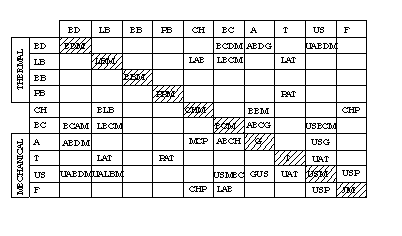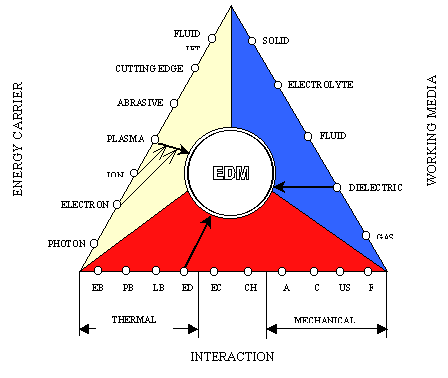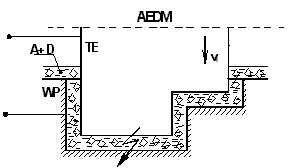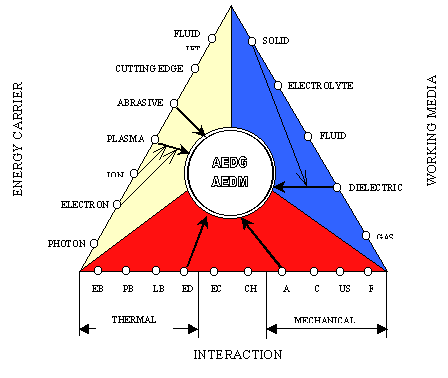Section 2. General Issues in Cross Process Study
There are generally two categories of Cross Machining Processes:
-
Processes in which all constituent processes are directly involved in the material removal, and
-
Processes in which only one of the participating processes directly removes the material while the others only assist in removal by changing the conditions of machining in a “positive” direction from the point of view of improving capabilities of machining.
In both of these categories, thermal, chemical, electro-chemical, photon-chemical, and mechanical interactions with the target may occur. The general issues in cross pross study is to integrate different processes, making use of their individual advantages while avert their adverse effects. The first step is to understand the interactions involved in various machining processes. To develop a practical process for industry, the overall feasibility should also be evaluated. Normally the cross process is more complex than the individual processes. The benefits should be big enough for the industry to accept it as a feasible solution to their problems. The effects of various interactions in the machining processes are discussed below. The feasibility problems will be discussed in individual processes.
Thermal Interactions
Laser beam treatment (LBT), welding (LBW) and machining (LBM), electron beam machining(EBM), electrical discharge machining (EDM), and plasma beam machining (PBM) are thermal processes where the material is removed through phase changes, either by melting or vaporization. Many secondary phenomena relating to surface quality, such as micro-cracking, formation of heat-affected zone and formation of striations, may also be related to the thermal effects of the above processes.
If the distribution of the power density of a heat source on a treated surface as result of energy source is known, the temperature field can be determined and finally it is possible to estimate the critical power density needed to reach a given temperature at a given point or in a given point in a given volume of the material in a given time interval tI (pulse duration). For instance, the critical power density required to reach on the surface of the melting temperature Tm or the boiling temperature Tb under normal pressure at the workpiece surface can be determined [4].
To
estimate the power density (![]() ) needed to obtain the temperature Tm on
the surface, the one-dimensional model of heating of semi-infinite body
by a heat source with the intensity constant in time can be used [4]:
) needed to obtain the temperature Tm on
the surface, the one-dimensional model of heating of semi-infinite body
by a heat source with the intensity constant in time can be used [4]:
 (1)
(1)
where a and l are thermal diffusivity and conductivity respectively.
The
critical value of heat power density (![]() ), which leads to evaporation, can be estimated from the following
equation [4]:
), which leads to evaporation, can be estimated from the following
equation [4]:
 (2)
(2)
where r is the density of workpiece material
The
time ![]() required to reach a given
temperature on the surface of the material, for example, to boiling point
Tb, increases with an increasing boiling temperature,
heat conduction l,
and specific heat of the material C, and decreases with increasing
heat power density q. To estimate the value of
required to reach a given
temperature on the surface of the material, for example, to boiling point
Tb, increases with an increasing boiling temperature,
heat conduction l,
and specific heat of the material C, and decreases with increasing
heat power density q. To estimate the value of ![]() , we can use the expression obtained from the one-dimensional
model of heating of a semi-infinite solid:
, we can use the expression obtained from the one-dimensional
model of heating of a semi-infinite solid:
![]() (3)
(3)
The
above expressions (1-3) can be used to estimate the characteristics of heat
sources for removal processes in EDM, LBM, EBM and PBM.
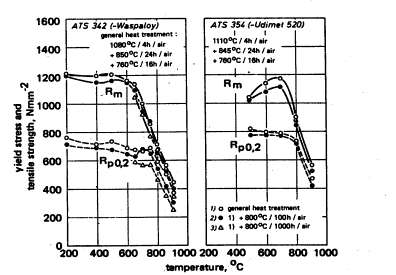
|
The resistance of workpiece material to mechanical removal process by cutting edge or abrasives (random oriented edges) depend on the high temperature (below melting point) generated at the machining zone. It is known that stress-strain curves and the flow and fracture properties derived from the tension test strongly depend on the temperature at which the test is conducted. In general, the strength decreases and ductility increases as the temperature is increased. For example, the temperature dependence of the strength for heat resistant Ni-base superalloys is illustrated Figure 1 [5]. Therefore, it is quite logical to assume that high temperatures reduce the cutting forces and the energy consumption, and increase the machinability of workpiece material by mechanical removing processes. Some cross processes has been developed according to this idea, such as laser assisted ECM (Section 3) and laser or plasma assisted machining of ceramics (Section 5).
In chemical or electrochemical interactions, an increase in temperature leads to acceleration of kinetic reactions on heated surfaces, such as anodic dissolution or cathodic deposition. The effect of temperature on the rate of these processes (i.e. on current density iL, which determines the rate of dissolution/deposition) is described by following Arrhenius equation:
 (4)
(4)
where ,
To, and Ts are initial and final (after
heating) surface temperatures respectively, ![]() is the increment in temperature,
io is current density without heating i.e. at
is the increment in temperature,
io is current density without heating i.e. at ![]() = 0, E0 is the activation energy, and R
is the gas constant.
= 0, E0 is the activation energy, and R
is the gas constant.
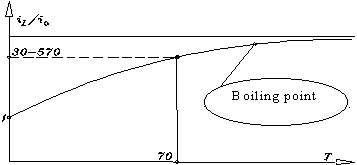 |
| Fig.
2 Effect of temperature on the current density of ECM electrode [6] |
The value
of iL/i0 at a temperature increase
of DT =
70, i.e., near the boiling point of the electrolyte, depends on the workpiece
material. For steel, copper, etc, the value of iL/i0
changes in a range from 30 to 570!
Chemical
and Electro-chemical Interaction
Chemical
milling (CM), etching (E), electrochemical machining (ECM), pulse electrochemical
machining (PECM), electropolishig (EP) are shaping
and finishing processes based on the dissolution of materials.
Chemical
milling is the selective and controlled metal removal by chemical action.
It is especially useful for removing metals from sheet components to reduce
weight, and it can be employed after parts have been formed and heat-treated.
Any metal that can be chemically dissolved in solution can be chemically
milled.
Electrochemical shaping and finishing is based on controlled anodic electrochemical dissolution process of the workpiece (anode) with a cathode tool in an electrolytic cell. Being a non-mechanical metal removal process, ECM is capable of machining any electrically conductive materials with high stock removal rates regardless of their mechanical properties, such as hardness, elasticity and brittleness. Shaping by electrochemical dissolution is described by the distribution of the dissolution velocity, Vn, on the anode-workpiece surface,
![]() (5)
(5)
where KV
is the electrochemical machinabilty coefficient, which
is defined as the volume of material dissolved per unit electrical charge,
and ia is the current density on anode-workpiece surface.
The assistance of other actions during electrochemical machining
is determined by their effect on KV and ia,
such as the effect of heating on electrochemical processes described by
equation (4).
The
interaction of chemical and electrochemical processes with
other removal processes is mainly based on their influence on the physical
properties of the workpiece surface layer and the working media.
The effect of electrochemical and chemical processes contributes in changing
the dislocation density in surface layer of the workpiece material. And
due to the reduction in surface potential energy during dissolution, plastic
deformation is easier and the level of work hardening is decreased. Fig.
3 illustrates the change of surface microhardness (HV)
during anodic dissolution[7]. As seen in the figure, even with relatively
low current densities, significant reduction in microhardness occurs. For
example, in the case of 3H13 steel, surface microhardness reduces from 220
MPa at i = 0A/cm2 to 168 MPa at i = 1A/cm2.
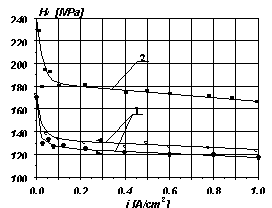 |
|
Fig.
3 Effect of current density of anodic dissolution on the microhardness
of machining surface (electrolyte: water solution of NaNO3
– 50 g/l, and NaNO2
– 10 g/l; material: Armco-curves 1, 3H13 steel-curve 2) [7]
|
Chemical
and electrochemical action can influence the physical conditions in the
machining zone. For example, generation of gas bubbles during electrochemical
reaction is the major factor in electrical discharges in an electrolyte.
Chemical and electrochemical actions may increase
the radiation absorptivity of metals and thus decrease the radiation energy
thresholds for melting and vaporization during laser action.
Mechanical
Interactions
Traditional cutting, grinding and abrasive finishing methods are based on mechanical interactions of the cutting edge with the workpiece materials. Mechanical interactions also play important roles in water jet machining and ulttrasonic machining. Freedom of movement can be added to the various machining processes which increase the flexibility of the porcesses. The mechanical assistance in the thermal and/or electrochemical removal processes is based on their influences on the properties of the workpiece and the working media.
Mechanical interactions can improve the working conditions in the anodic dissolution processdue to mechanical depassivation of the surface. By removing a thin layer of oxides and other compounds from the anode, the surface dissolution is intensified and the smoothness of the machined surface can be increased. Mechanical interactions can increase the machining rate but may leave substantial residual stresses which may be undesirable. While chemical processes can relieve the residual stresses. Thus it's attractive to combine these beneficial effects in one process. It has been found that as a result of mechanical depassivation, material removal rate by dissolution process (electrochemical grinding) has been increased by 100-142% when grinding T15KG carbides, by 21-44% for H18N10T steel, and by 32-71% for Armco iron [7].
Significant effects of mechanical action can be generated by ultrasonic wave. The cavitation generated by ultrasonic vibration can enhance the EDM, ECM and LBM processes. In ultrasonically assisted EDM or LBM drilling, it is recognised that the role of the acoustic wave and cavitation is to improve the flushing and the material removal from the surface craters. These process condition improvements are significant for micro drilling and grooving.
